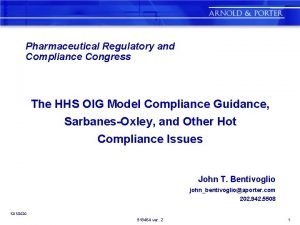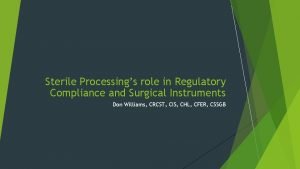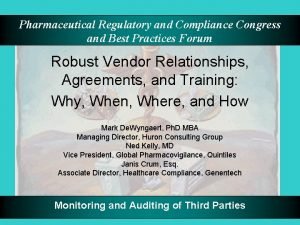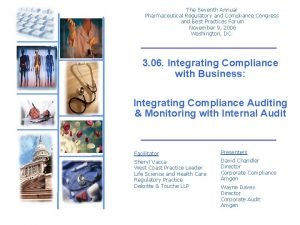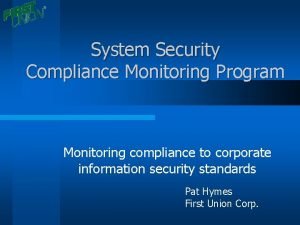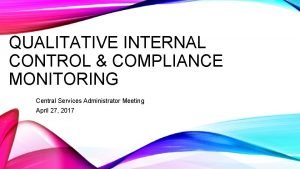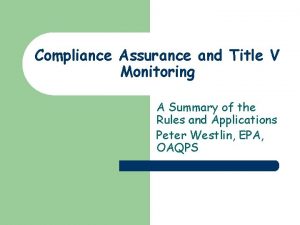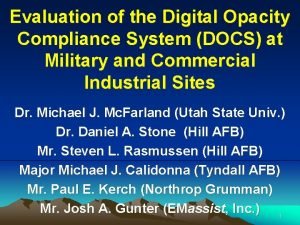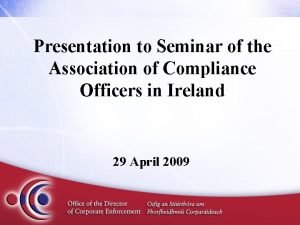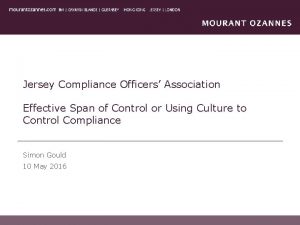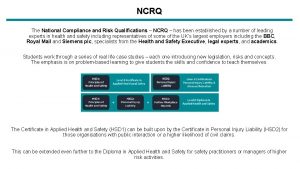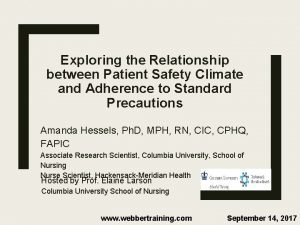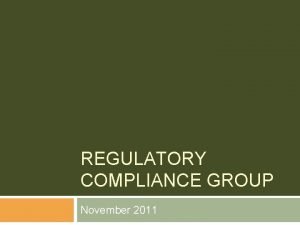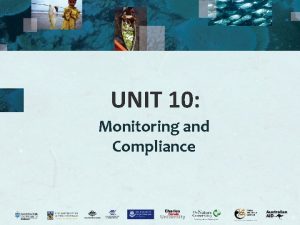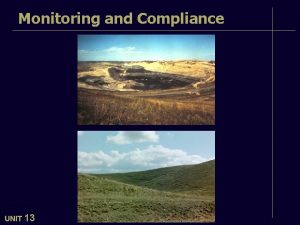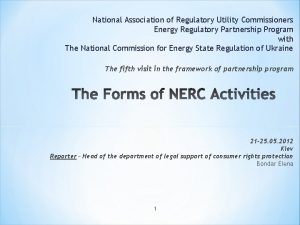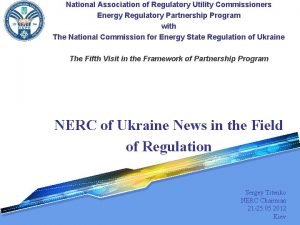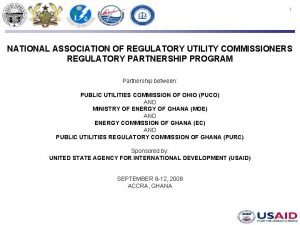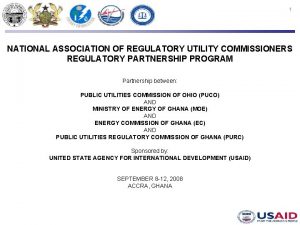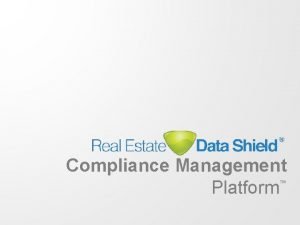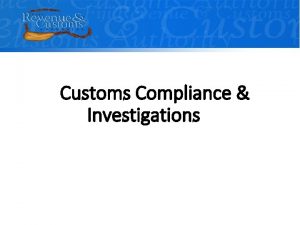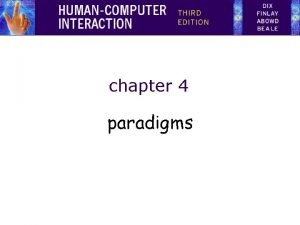Regulatory Compliance Monitoring Paradigms National Association for Regulatory
















- Slides: 16

Regulatory Compliance Monitoring Paradigms National Association for Regulatory Administration Richard Fiene, Ph. D. February 2017

Regulatory Compliance Monitoring Paradigms Introduction • This presentation provides some key elements to the two dominating paradigms (Relative versus Absolute) for regulatory compliance monitoring based upon the Theory of Regulatory Compliance. See the next slide for the key elements summarized for the Monitoring Paradigms followed by a more detailed description of each key element in the remaining slides. These key elements are all interrelated and at times are not mutually exclusive.

Regulatory Compliance Monitoring Paradigms • • • Relative <-------------------------------------------------> Absolute Substantial <----------------------------------------------> Monolithic Differential Monitoring <---------------------------> One size fits all monitoring Not all standards are created equal <-----------------> All standards are created equal Do things well <--------------------------------------------> Do no harm Strength based <------------------------------------------> Deficit based Formative <-----------------------------------------------> Summative Program Quality <------------------------------------> Program Compliance 100 -0 scoring <-----------------------------------------> 100 or 0 scoring QRIS <---------------------------------------------------> Licensing Non Linear <--------------------------------------------------> Linear

Regulatory Compliance Monitoring Paradigms Organizational Key Element • Relative versus Absolute Regulatory Compliance Paradigm: this is an important key element in how standards/rules/regulations are viewed when it comes to compliance. For example, in an absolute approach to regulatory compliance either a standard/rule/regulation is in full compliance or not in full compliance. There is no middle ground. It is black or white, no shades of gray. It is 100% or zero. In defining and viewing these two paradigms, this dichotomy is the organizational key element for this presentation.

Regulatory Compliance Monitoring Paradigms Key Element 1 • Substantial versus Monolithic: in monolithic regulatory compliance monitoring systems, it is one size fits all, everyone gets the same type of review (this is addressed in the next slide) and is more typical of an absolute paradigm orientation. In a substantial regulatory compliance monitoring system, programs are monitored on the basis of their past compliance history and this is more typical of a relative paradigm orientation. Those with high compliance have fewer and more abbreviated visits/reviews while those with low compliance have more comprehensive visits/reviews.

Regulatory Compliance Monitoring Paradigms Key Element 2 • Differential Monitoring versus One Size Fits All Monitoring: in differential monitoring (Relative Paradigm), more targeted or focused visits are utilized spending more time and resources with those problem programs and less time and resources with those programs that are exceptional. In the One Size Fits All Monitoring (Absolute Paradigm), all programs get the same type/level of review/visit regardless of past performance.

Regulatory Compliance Monitoring Paradigms Key Element 3 • Not all standards are created equal versus All standards are created equal: when looking at standards/rules/regulations it is clear that certain ones have more of an impact on outcomes than others. For example, not having a form signed versus having proper supervision of clients demonstrates this difference. It could be argued that supervision is much more important to the health and safety of clients than if a form isn’t signed by a loved one. In a relative paradigm, all standards are not created nor administered equally; while in an absolute paradigm of regulatory compliance, the standards are considered created equally and administered equally.

Regulatory Compliance Monitoring Paradigms Key Element 4 • “Do things well” versus “Do no harm”: “doing things well” (Relative Paradigm) focuses on quality of services rather than “doing no harm” (Absolute Paradigm) which focuses on health and safety. Both are important in any regulatory compliance monitoring system but a balance between the two needs to be found. Erring on one side of the equation or the other is not in the best interest of client outcomes. "Doing no harm" focus is on the "least common denominator" – the design and implementation of a monitoring system from the perspective of focusing on only 5% of the nonoptimal programs ("doing no harm") rather than the 95% of the programs that are "doing things well".

Regulatory Compliance Monitoring Paradigms Key Element 5 • Strength based versus Deficit based: in a strength based monitoring system, one looks at the glass as “half full” rather than as “half empty” (deficit based monitoring system). Emphasis is on what the programs are doing correctly rather than their non-compliance with standards. A strength based system is non-punitive and is not interested in catching programs not doing well. It is about exemplars, about excellent models where everyone is brought up to a new higher level of quality care.

Regulatory Compliance Monitoring Paradigms Key Element 6 • Formative versus Summative: relative regulatory compliance monitoring systems are formative in nature where there is an emphasis on constant quality improvement and getting better. In absolute regulatory compliance monitoring systems, the emphasis is on being the gate-keeper and making sure that decisions can be made to either grant or deny a license to operate. It is about keeping nonoptimal programs from operating.

Regulatory Compliance Monitoring Paradigms Key Element 7 • Program Quality versus Program Compliance: relative regulatory compliance monitoring systems focus is on program quality and quality improvement while in absolute regulatory compliance monitoring systems the focus in on program compliance with rules/regulations with the emphasis on full, 100% compliance.

Regulatory Compliance Monitoring Paradigms Key Element 8 • 100 – 0 scoring versus 100 or 0 scoring: in a relative regulatory compliance monitoring system, a 100 through zero (0) scoring can be used where there are gradients in the scoring, such as partial compliance scores. In an absolute regulatory compliance monitoring system, a 100% or zero (0) scoring is used demonstrating that either the standard/rule/regulation is fully complied with or not complied with at all.

Regulatory Compliance Monitoring Paradigms Key Element 9 • QRIS versus Licensing: examples of a relative regulatory compliance monitoring system would be QRIS – Quality Rating and Improvement Systems. Absolute regulatory compliance systems would be state licensing systems. Many programs talk about the punitive aspects of the present human services licensing and monitoring system and its lack of focus on the program quality aspects in local programs. One should not be surprised by this because in any regulatory compliance system the focus is on "doing no harm" rather than "doing things well". It has been and continues to be the focus of licensing and regulations in the USA. The reason QRIS - Quality Rating and Improvement Systems developed in early care and education was to focus more on "doing things well" rather than "doing no harm".

Regulatory Compliance Monitoring Paradigms Key Element 10 • Non-Linear versus Linear: the assumption in both relative and absolute regulatory compliance monitoring systems is that the data are linear in nature which means that as compliance with standards/rules/regulations increases, positive outcomes for clients increases as well. The problem is the empirical data does not support this conclusion. It appears from the data that the relationship is more non-linear where there is a plateau effect with regulatory compliance in which client outcomes increase until substantial compliance is reached but doesn’t continue to increase beyond this level. There appears to be a “sweet spot” or balancing of key standards/rules/regulations that predict client outcomes more effectively than 100% or full compliance with all standards/rules/regulations – this is the essence of the Theory of Regulatory Compliance – substantial compliance with all standards or full compliance with a select group of standards that predict overall substantial compliance and/or positive client outcomes.

Regulatory Compliance Monitoring Paradigms Conclusion • As the regulatory administration field continues to think about the appropriate monitoring systems to be designed and implemented, the above structure should help in thinking through what these systems’ key elements should be. Both paradigms are important, in particular contexts, but a proper balance between the two is probably the best approach in designing regulatory compliance monitoring systems.

For Additional Information: • Richard Fiene, Ph. D. , Senior Licensing Measurement Consultant • National Association for Regulatory Administration (NARA) • RFiene@NARALicensing. org • Research Psychologist • Research Institute for Key Indicators (RIKILLC) • RIKI. Institute@gmail. com • Affiliate Professor, Prevention Research Center • The Pennsylvania State University • RJF 8@PSU. EDU
 Oig pharma compliance guidance
Oig pharma compliance guidance Cssd regulatory compliance
Cssd regulatory compliance Pharmaceutical regulatory and compliance congress
Pharmaceutical regulatory and compliance congress Regulatory compliance
Regulatory compliance Pharmaceutical regulatory and compliance congress
Pharmaceutical regulatory and compliance congress Pharmaceutical regulatory and compliance congress
Pharmaceutical regulatory and compliance congress Security compliance monitoring
Security compliance monitoring Compliance monitoring missoula
Compliance monitoring missoula Contractor compliance and monitoring inc
Contractor compliance and monitoring inc Hpe green lake
Hpe green lake Greenlake hybrid cloud
Greenlake hybrid cloud Compliance assurance monitoring
Compliance assurance monitoring Digital smoke ogden ut
Digital smoke ogden ut Association of compliance officers in ireland
Association of compliance officers in ireland Jersey compliance officers association
Jersey compliance officers association Ncrq diploma assignments
Ncrq diploma assignments National safety compliance quiz answers 11-013
National safety compliance quiz answers 11-013
